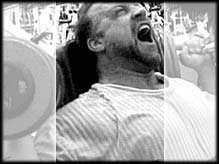Resistance training is the best natural stimulus for muscular growth. Many weight training programs have been developed over the years in an attempt to modify and manipulate this natural process, each with varying degrees of success. The truth is, the success of a program is often determined by its ability to elicit a specific hormonal response, and little else.
Using Specific Styles
Hormones circulating during and after workouts directly affect muscle adaptation. Unfortunately, this is one of the most misunderstood aspects of resistance training. If we as trainers understood the natural anabolic activity in our clients resulting from specific styles of strength training, we could surely design more effective programs enabling our clients to recover faster, adapt and grow more effectively. Let's look at the factors of muscle fiber recruitment, and manipulating serum testosterone and growth hormone levels through resistance training.
 The average beginning trainee knows that high repetitions (15 repetitions or more) is best for muscular endurance, and is not conducive to gaining muscular mass. The light weight used in high repetition work is not enough to innervate the higher threshold motor units in a muscle. The key is that only muscle fibers activated by the resistance training will respond to increased levels of anabolic hormones. When heavier weights (lower reps) are used in resistance training, more muscle fibers are recruited. The more muscle fibers recruited for an exercise, the greater the extent of remodeling in the entire muscle.
The average beginning trainee knows that high repetitions (15 repetitions or more) is best for muscular endurance, and is not conducive to gaining muscular mass. The light weight used in high repetition work is not enough to innervate the higher threshold motor units in a muscle. The key is that only muscle fibers activated by the resistance training will respond to increased levels of anabolic hormones. When heavier weights (lower reps) are used in resistance training, more muscle fibers are recruited. The more muscle fibers recruited for an exercise, the greater the extent of remodeling in the entire muscle.
There is another reason that light weight and high repetitions are not optimal for stimulating muscular hypertrophy. The majority of the work done in high repetition sets is accomplished by slow-twitch Type I muscle fibers. Type I muscle fibers have a limited ability to hypertrophy. Type IIB fibers are activated when more force is required, and thus have the greatest potential for growth. Heavier weights accomplish more complete activation of the type 11B muscle fibers.
Very Low or Very High?
According to the size principle, motor units are recruited in order according to their recruitment thresholds and firing rates. Since most muscles contain a range of Type I and Type II fibers, force production can be very low or very high. Therefore, to get to a high-threshold motor unit, all of the motor units below it must be sequentially recruited. Heavy resistance training recruits these high threshold motor units, therefore all the units below it can undergo hormonal adaptations to the stress of the heavy loads.
An increase in serum testosterone levels is one result of heavy resistance training. Since testosterone is the primary hormone that interacts with skeletal muscle tissue, it has both direct and indirect effects on muscle tissue. Resistance training utilizing large muscle groups of the lower body (squats, deadlifts) can increase serum testosterone concentrations more than other types of exercises. Using a resistance of 85%-95% of one-rep maximum will also increase testosterone levels more than other resistance loads.
Many aspiring novices will attempt to lift near 1 RM loads for one or two repetitions in the hopes of gaining muscle size. Although heavy resistance does innervate high threshold motor units, serum testosterone levels are increased through moderate to high volume of exercises. This is achieved through multiple sets, exercises, and a moderate repetition range (around 10 repetitions), with short rest intervals (between 30 seconds to 1 minute).
 For gains in muscular size, smaller motor units need to be recruited first in each set of exercise. As the set progresses in intensity, larger units will then be recruited. If the low threshold motor units are inhibited to recruit the high threshold motor units for explosive movements (as in powerlifting), the low threshold units that are not activated will not undergo hormonal adaptations.
For gains in muscular size, smaller motor units need to be recruited first in each set of exercise. As the set progresses in intensity, larger units will then be recruited. If the low threshold motor units are inhibited to recruit the high threshold motor units for explosive movements (as in powerlifting), the low threshold units that are not activated will not undergo hormonal adaptations.
This is because of the size principle of muscle fiber recruitment. Since motor units are recruited in an orderly fashion (from low threshold to high) and can span a range of muscle fiber types (Type I and Type II), then a moderate range of repetitions must be used to recruit the entire spectrum of fibers. This recruitment pattern allows the full spectrum of fibers to adapt to the training by increasing sensitivity to circulating anabolic hormones.
After a muscle has been subjected to intense stress through maximal force contractions over a moderate repetition range, hormones begin the growth process and muscle remodeling. Growth hormone plays a vital role in adapting to the stress of resistance training. Growth hormone levels can be increased through resistance training through high intensity (10 repetitions coupled with heavy resistance) with three sets of each exercise (high total workload) and short, one minute rest periods. Once the levels are elevated, a cascade of events occur; decreased glucose utilization, increased amino acid transport across cell membranes, increased protein synthesis, increased utilization of fatty acids, increased lipolysis (fat breakdown), enhanced immune functions, and a promotion of compensatory renal hypertrophy.
Conclusion
An understanding of natural anabolic activity, which occurs in your clients' bodies, is essential to muscular adaptation, successful recovery, training progression, and ultimately muscular gains. High repetition resistance training (15 repetitions or more) does not innervate high threshold motor units and therefore limits the potential for Type IIB muscle fiber hypertrophy.
Powerlifting, which does not allow for sufficient time to activate all motor units in an orderly fashion, diminishes the hormonal adaptations of the entire span of muscle fibers in any given motor unit. Only resistance training that is high in intensity, utilizing 8-10 repetitions, heavy resistance and a maximum of one minute rest between sets will maximize serum testosterone and growth hormone levels, thus allowing for successful recovery, adaptation, and muscular growth.
